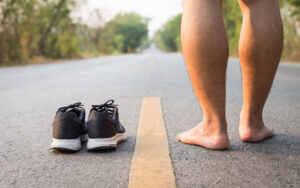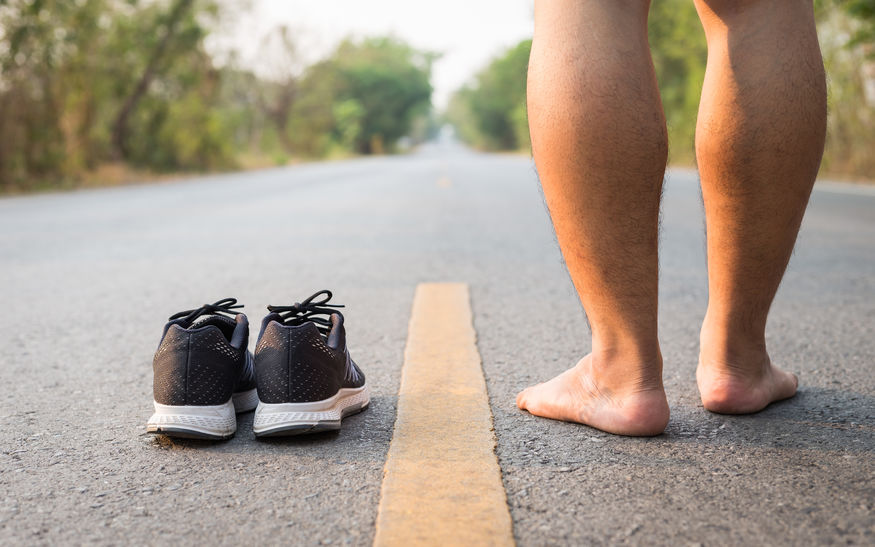Most avid runners will describe their chosen sport as liberating, challenging, a great way to commune with nature and, most of all, simplistic in its equipment requirements. One can just don a pair of high-quality running shoes and hit the open road. Or might it be even easier than that? In recent years, a debate has begun to surface regarding the most optimal choice of footwear when running.

While there are those athletes and professionals who are staunch believers in a running shoe whose construction offers ample cushioning and shock absorption, lateral support, and appropriate space in the toe box, there seem to be just as many avid supporters of what has come to be known as the minimalistic footwear revolution.
Researchers have delved into this topic with great enthusiasm, eager to prove the theories that seem to have sprung up overnight, questioning the need for protective foot covering while running. At its most elemental form, the primary argument relates simply to the physics of a collision. During a foot strike, the moment when the body meets the ground an impact is generated, which can be defined by Sir Isaac Newton’s 2nd Law: Force = Mass x Acceleration. The mass in this collision refers to whatever portion of the body that comes to a dead stop along with the point of impact on the foot. The acceleration is the rate of change of this mass’ velocity.
Keeping these parameters in mind, studies have been done on elite runners wearing shoes (and favoring a heel-strike) as well as those in minimalistic footwear or even barefoot, where a forefoot or mid-foot strike usually occurs. Some data has revealed that the initial impact shock experienced by the body of a runner wearing shoes is equivalent to three times his/her body weight, compared with a 0% impact shock felt by barefoot runners. Thus, one popular theory purports that higher impact forces and loading rates equal a greater risk of injury, suggesting that perhaps runners who are barefoot or minimally should have a better chance of avoiding injury than those favoring supportive footwear. While this notion has come under scrutiny and dispute, it nevertheless remains quite viable among many avid runners.
Going Barefoot? Better Walk Before You Run
As is human nature, whenever a new idea pops up with regard to any manner of fitness, there are always going to be those eager individuals who plunge headlong into the said new territory without proper planning and evaluation. The running footwear arena is no exception. Whether one fully buys into the heel-strike/forefoot strike impact or not, runners who hastily attempt to make the switch from protective footwear to minimalistic or barefoot running are practically asking for injury. If a normally shoe-clad runner suddenly opts for a barefoot run without being accustomed to it, the ingrained pattern of landing on the heel will result in an impact loading rate that is seven times greater than running in shoes with the same landing. Hence, what has been observed is that runners who are accustomed to exercising in shoes are exposing themselves to a greater risk of injury, simply as a result of not properly transitioning to the barefoot method.
Whether one adheres to the benefits of running in a well-constructed and supportive shoe or favors the barefoot method, one thing has become abundantly clear: the transition from footwear to the lack thereof is of the utmost importance in terms of avoiding serious injury. The forefoot striking observed in minimal footwear requires the use of muscles in the feet (mostly in the arch) that may be very weak in individuals who have been training in shoes. Running in this fashion also requires much more calf strength than heel striking, owing to the fact that these muscles must contract eccentrically (while lengthening) to ease the heel onto the ground following the landing. During this process of transitioning, heel-strikers typically experience tired feet and sore calf muscles. In addition, the Achilles tendon often becomes very stiff. While this is normal, and with practice will dissipate over time, there are several training tips that can ease the transition and ultimately make it more successful:
- Build up slowly! As with any muscle in your body, those in the feet and calves will be sore and stiff. Easing into the new gait pattern will help to stave off injury.
- Increase the time spent walking around barefoot.
- During the first week of transition, attempt to run no greater than a quarter-mile to a mile every other day.
- Consider increasing training distance by no more than 10% every week, depending on the level of soreness experienced.
- Pain is a sign that the body needs to re-adjust and heal. Pay attention to acute discomfort.
- Over the course of several months, gradually increase the proportion of forefoot or mid-foot striking and reduce the proportion of heel-strike running with shoes.
- Stretching and massaging the calf and hamstring muscles as well as the arches will facilitate the breaking down of scar tissue, enabling the muscles to heal and become stronger during the transition.
At this point in the discussion, it is prudent to point out that barefoot running, quite simply, may not be ideal for all athletes. Some runners may have been born with certain structural problems that cannot be eradicated, regardless of their preference in running gear. In other instances, mostly among slightly older athletes, decades of running in well-constructed shoes may have caused changes that simply cannot be reversed. Avid marathoners sometimes possess muscle weaknesses elsewhere in their bodies, and barefoot running may not be a panacea to overcome these imbalances.
While the benefits of a forefoot or mid-foot strike are evidenced time and again, for those athletes with a very real need for supportive orthotics built into their shoes, minimalistic footwear may never be a viable option. Regardless of your choice of footwear, gaining an understanding of the mechanics and physics of running can always help provide a perspective when analyzing your movement patterns. A smart, well-informed athlete will be more inclined to enjoy injury-free longevity, in a body that was made to move.
References:
1. Lieberman DE, Venkadesan M, Werbel WA, Daoud AI, D’Andrea S, Davis IS, Mang’eni RO, Pitsiladis Y. (2010) Foot strike patterns and collision forces in habitually barefoot versus shod runners. Nature 463: 531-5.
2. Bramble DM and Lieberman, DE (2004) Endurance running and the Evolution of Homo. Nature. 432: 345-352.
4. http://www.invisibleshoe.com/1147/barefoot-running-vs-running-shoes/
5.



